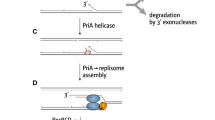Summary
The molecular mechanisms of the RecBC and RecF pathways for genetic recombination in E. coli were investigated by studying the kinetics of RecA protein function during conjugation. RecF recombination in recBC sbcB mutants is shown to be a much slower process than RecBC recombination in recBC + sbcB +strains, and is blocked by a mutation in lexA that prevents induction of RecA protein. Progress of the RecF pathway is greatly accelerated by a recAoc mutation which increases synthesis of RecA protein, but this does not restore recombination proficiency to a recBC sbcB lexA mutant. These results are interpreted to suggest that the RecF pathway directs integration of single-stranded Hfr DNA into the recipient chromosome whereas the RecBC pathway catalyses the exchange of largely double stranded DNA. This is consistent with the known stoichiometry of RecA protein catalysed heteroduplex DNA formation in vitro and with the delayed replication of RecF pathway recombinants which approximates to the time required for one round of DNA replication to generate homoduplex DNA. The regulation of the RecF pathway by lexA repressor is discussed in relation to the factors that govern the relative utilization of the two recombination pathways in wild-type cells.
Similar content being viewed by others
References
Arthur HM, Lloyd RG (1980) Hyper-recombination in uvrD mutants of Escherichia coli K12. Mol Gen Genet 180:185–191
Birge EA, Low KB (1974) Detection of transcribable recombination products following conjugation in Rec+, RecB−, and RecC− strains of Escherichia coli K12. J Mol Biol 83:447–457
Bresler SE, Goryshin I Yu, Lanzov VA (1981) The process of general recombination in Escherichia coli K12. Structure of intermediate products. Mol Gen Genet 183:139–143
Clark AJ (1973) Recombination deficient mutants of E. coli and other bacteria. Ann Rev Genet 7:67–86
Clark AJ (1980) A view of the RecBC and RecF pathways of E. coli recombination. In: Alberts B (ed) Mechanistic studies of DNA replication and genetic recombination. 891–899 (ICN-UCLA Symp XIX)
Cox MM, Lehman IR (1981) recA protein of Escherichia coli promotes branch migration, a kinetically distinct phase of DNA strand exchange. Proc Natl Acad Sci USA 78:3433–3437
Dower NA, Stahl FW (1981) X-activity during transduction-associated recombination. Proc Natl Acad Sci USA 78:7033–7037
Dressler D, Potter H (1982) Molecular mechanisms in genetic recombination. Ann Rev Biochem 51:727–761
Karu AE, Belk ED (1982) Induction of E. coli recA protein via recBC and alternate pathways: Quantitation by enzyme-linked immunosorbent assay (ELISA). Mol Gen Genet 185:275–282
Kolodner R (1980) Genetic recombination of bacterial plasmid DNA: Electron microscopic analysis of in vitro intramolecular recombination. Proc Natl Acad Sci USA 77:4847–4851
Laban A, Cohen A (1981) Interplasmidic and intraplasmidic recombination in Escherichia coli K-12. Mol Gen Genet 184:200–207
Little JW, Harper JE (1979) Identification of the lexA gene product of Escherichia coli K12. Proc Natl Acad Sci USA 76:6147–6151
Little JW, Edmistion SH, Pacelli LZ, Mount DW (1980) Cleaveage of the Escherichia coli lexA protein by recA protease Proc Natl Acad Sci USA 77:3225–3229
Lloyd RG (1983) lexA dependent recombination in uvrD strains of Escherichia coli. Mol Gen Genet 189:157–161
Lloyd RG, Johnson S (1979) Kinetics of recA function in conjugational recombinant formation. Mol Gen Genet 169:219–228
Lloyd RG, Low B (1976) Some genetic consequences of changes in the level of recA gene function in Escherichia coli K-12. Genetics 84:675–695
Lloyd RG, Low B, Godson GN, Birge EA (1974) Isolation and characterisation of an Escherichia coli K-12 mutant with a temperature-sensitive RecA− phenotype. J Bacteriol 120:407–415
Mahajan SK, Datta AR (1979) Mechanisms of recombination by the RecBC and RecF pathways following conjugation in Escherichia coli K12 Mol Gen Genet 169:67–78
Meselson MS, Radding CM (1975) A general model for genetic recombination. Proc Natl Acad Sci USA 72:358–361
Phizicky EM, Roberts JW (1981) Induction of SOS functions: Regulation of proteolytic activity of E. coli RecA protein by interaction with DNA and nucleotide triphosphate. Cell 25:259–267
Telander Muskavitch KM, Linn S (1981) A unified mechanism for the nuclease and unwinding activites of the recBC enzyme of Escherichia coli. J Biol Chem 257:2641–2648
Thomas A, Lloyd RG (1980) Altered regulation of the recA gene in Escherichia coli strains carrying a recA-linked suppressor of lexA. Mol Gen Genet 179:355–358
Author information
Authors and Affiliations
Additional information
Communicated by B.A. Bridges
Rights and permissions
About this article
Cite this article
Lloyd, R.G., Thomas, A. On the nature of the RecBC and RecF pathways of conjugal recombination in Escherichia coli . Mol Gen Genet 190, 156–161 (1983). https://doi.org/10.1007/BF00330339
Received:
Issue Date:
DOI: https://doi.org/10.1007/BF00330339




